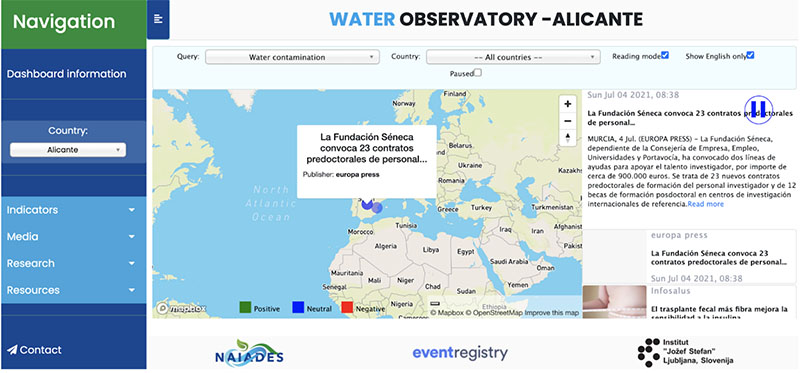The water sector is facing rapid development in the direction of the smart digitalisation of resources, much motivated and supported by the UN global initiative of the Sustainable Development Goal 6. In that context, the efforts to address the specific challenges related to water management data and priorities multiply globally. There are several “digital twin” systems dedicated to water, each of which focusing on the different aspects of the digitalisation of signal to support water management companies, as well as water “observatories”, that are usually meant as Geographical Information Systems that showcase the different aspects of water resources through time.
In the European Commission's research and innovation project NAIADES (https://naiades-project.eu/) we propose a slightly different approach that integrates heterogeneous data sources to try and solve common research questions, as well as to support water management companies in their current problems. The continuous observation of water-related events can help water resource management institutions, local governments and the general public to have a wider perspective on their own water resources and usage, on the dimension of several water priorities defined, and on the awareness of how to properly address selected water events. The NAIADES Water Observatory is ingesting heterogeneous data sources to provide different angles to the water-event analysis.
The NAIADES Water Observatory was built by UNESCO’s AI research center IRCAI through the Institute Jozef Stefan, in collaboration with the NAIADES consortium partners, and is now released at naiades.ijs.si, but is soon to be integrating the bigger picture of the NAIADES platform of services serving the Water Sector. In this Water Observatory we are putting together: (i) real-time information from multilingual world news on water topics; (ii) data visualisation of water-related indicators through time, sourced directly from the Sustainable Development Goal 6 portal dedicated to water, and other publicly available open data; (iii) scientific knowledge from published research on water-related topics (e.g., water contamination) over more than 126 million articles; and (iv) geolocated historical data on water resources and weather conditions to analyse and forecast the impact of climate change in the sector with specification to the region where the water resources are located.

Figure 1 - Screenshot of the Pilot 1 of the NAIADES Water Observatory showcasing the feed of news tailored to the local priorities in water-related news monitoring
This innovative technology is capable of providing the user with a global-to-local perspective on water-related events and trends through a range of perspectives complementing each other but even richer in their interaction (e.g., news, social media and weather) exposing insightful water-related information. The latter is configured to the user's priorities and needs, from the data integration of heterogeneous sources to the filtering of the news and social media feeds. This allows us to analyze the information from social media when the weather is favorable to floods, and explore the historical information from news and published research on these weather-related events to learn how to better take decisions to prevent them or improve their impacts. This is complemented by data ingested from global and local indicators, showcasing the observation of water-related datasets linked to SDG 6 with country and regional granularities that can help us observe changes and trends.
The exploration of best practices from sometimes hard to find common problems can find great use on this elaborated research over worldwide news, informing institutions on the water events they did not know of, but also can leverage the advantage of the Water Observatory in the easier access to a vast dataset on published scientific research. This allows the user to explore the insights and methods provided in scientific articles validated by the corresponding venues, and the success stories that can be used in decision-making and water education at local level.
The users of this solution belong to three main scenarios with different workflows that can be supported by the developed technology:
- water resource management: using the provided information in the resolution of problems related to weather events, to understand how their actions are perceived by the consumers, and to explore successful scenarios in similar cases;
- local government: to help evidence-based decision-making using open data, better sync to SDG6 and other guidelines and evaluate commitments in time;
- general public: for water education with a local context, in aspects that matter to the local population, based on parts of the Water Observatory that can be open to public.

Figure 2 - Animated visualisation of water-related indicators comparing Spain to other countries based on global indicators derived from open data as, e.g., the Sustainable Development Goal 6
In the IRCAI approach, the water data sensing is done over dynamic open data sources that serve us as digital sensors (news, social media, indicators, publications, weather). This data is then integrated and visualised, each in its own tab, addressing specific topics of interest. The observatory is thus composed of all that heterogeneous data coming in in different frequencies. The interactions between those data sources to solve common problems make it a Water Digital Twin. The questions we are trying to solve with this innovative technology are, e.g., if we can predict water shortages in a certain region given the historical data; or if we can identify early signals of water-related problems from social media.
All of the views of this observatory, each of which represents digital solutions on their own, are configured to the local priorities of the NAIADES use cases as a Proof of Concept, showing that each can address specific conditions and priorities.
- Indicators: adding to the global UN indicators we are ingesting curated open datasets that have regional information about water topics of interest to the stakeholder
- Media: each location has its own news and social media streams configured to priorities and aspects of the news that stakeholders define as topics of interest (e.g. floods)
- Research: similarly to the media sources, the research topics allow for some customization to better fit to the needs of the local user
- Resources: the natural resources information provided for exploration is geolocated to the regions of interest to the user of the platform
It is relatively easy to include new use cases and corresponding workspaces after the discussions on user priorities that will allow us to configure the information presented and making it meaningful.

Figure 3 - Exploratory data analysis of the relation between news and tweets on water-related events and their relations with the overall sentiment
The priorities in European Union are rapidly changing towards sustainability and environmental efficiency, transversally to most domains of action. The European Commission’s Green Deal aiming for a climate neutral Europe in 2050, and boosting economy through green technology provides a new framework to understand and position water resource management in the context of the challenges of tomorrow. The NAIADES Water Observatory will not only contribute to the improvement of European sustainability in water-related matters, but will also provide the local actors on the water resource management an active role in that.
With that aim, the NAIADES team is intensively working to add the dimension of natural resources to the exploration scenarios of the Water Observatory, based on ingested weather data from the ECMWF (on humidity, temperature and rainfall) and other open data sources related to water levels of lakes and rivers, ingested into a sophisticated engine to explore the states of that historical data and analyse long-term forecasts to identify trends. This meaningful AI integration will allow for a better preparedness of the stakeholders on the water sector and local governments to prepare for the foreseen impacts on what, e.g., winter will be like in ten or thirty years from now based on what we know today.

Figure 4 - Analysis of the impact of the climate change in the characteristics of seasons in relation to water sources in Alicante
The research results show that there is a great potential in building business intelligence to the user of this Water Observatory that can be leveraged in the context of the priorities of the technology adopters in the Water Sector. The development of the solution will continue beyond the lifetime of the project within the coordination of IRCAI, also expanding to other areas relevant to the SDG 6. In time, new datasets will be ingested to better complement the information available, and new data exploration and visualisation modules will be made available to help the industry and local administration towards a better water sustainability.
The water resource management institutions and municipalities can also make public some of the tabs, tools and functionalities of the Water Observatory to create awareness on, e.g., the specific climate change impact in the region, and enhance the education on efficient water usage by the citizens, by agriculture and by industry. Further datasets can be prepared and ingested to explore causality relations and crowdsource the identification of partial solutions from water topic review over scientific articles and news articles, refining the search configurations and prioritized concepts.
Based on the ongoing discussions with the UNESCO Chair on Water-related Disasters Risk Reduction, the observation of water-related events will be further explored both at regional level throughout history, and at worldwide level to learn from the best practices under similar circumstances. The generalisation of the success story of the Water Observatory, built in the light of NAIADES requirements, to a wider coverage on the SDG 6 priorities that will further widen the scope of the observed events, helping the Water Sector to a better alignment.



